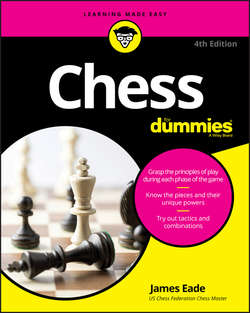Читать книгу Chess For Dummies - Eade James - Страница 14
На сайте Литреса книга снята с продажи.
Part 1
Laying the Groundwork for Champion Chess
Chapter 2
Getting to Know the Pieces and Their Powers
Scooting Around as the Army’s Runt: The Pawn
ОглавлениеAlthough chess people sometimes refer to all the chessmen collectively as pieces, they don’t really consider a pawn to be a piece. If you lose a knight, you can either say, “I lost a knight” or “I lost a piece,” but if you lose a pawn, you don’t say, “I lost a piece.” You say, “I lost a pawn” instead. (Why? Because that’s just the way chess people talk.) Pawns are only pawns, but chess has a lot of them!
Figure 2-16 shows how the pawns are set up at the start of the game.
© John Wiley & Sons, Inc.
FIGURE 2-16: The pawns line up for battle.
The pawns are the foot soldiers of chess, and you know how foot soldiers are treated. Their powers are very restricted. The pawn can move only one square forward, except on its very first move, when it has the choice of moving one or two squares forward. A pawn can’t move backward or sideways – only forward. Figure 2-17 shows the options for the white pawns at the starting line.
© John Wiley & Sons, Inc.
FIGURE 2-17: In the opening, the white pawns can move to the X-marked squares.
The pawn, unlike a piece, captures differently than it moves. It captures diagonally, one square forward to either side. But it still takes the opponent’s place on a square when it captures, just as the other chessmen do. Figure 2-18 illustrates the pawn’s capturing ability.
© John Wiley & Sons, Inc.
FIGURE 2-18: The white pawn can capture an opponent on either of the X-marked squares.
In Figure 2-19a, an enemy pawn occupies one of the squares that the white pawn can attack. Figure 2-19b shows how the white pawn captures the black pawn (although the black pawn could have captured the white pawn if it were black’s turn!).
© John Wiley & Sons, Inc.
FIGURE 2-19: Pawn fight: White captures black.
If no member of the opposing army occupies a square that the pawn attacks, then the pawn can move forward. If a piece or another pawn is in front of it, but nothing is on the squares the pawn can capture, the pawn is stymied and can’t move; chess players say the pawn is locked. In Figure 2-20, the pawns on d5 and d6 are locked … by each other.
© John Wiley & Sons, Inc.
FIGURE 2-20: A pair of pawns locks horns.
When two pawns are locked together as in Figure 2-20, you should try to bring another pawn alongside to help out. This strategy is so common that it’s referred to as a lever. You can see where that term comes from, because the second pawn attempts to pry the first one free. Figure 2-21 illustrates the use of the lever.
© John Wiley & Sons, Inc.
FIGURE 2-21: Pawn love and bravery, known as the lever.
I find it helpful to think of the foot soldier holding a spear and a giant shield. The shield is in front of the foot soldier so that the soldier can thrust only to the right or left side of the shield and can’t thrust in front of it. The soldier needs a comrade in arms to come to his aid.
With the additional pawn’s aid, now two of the pawns can capture each other. If the black pawn captures the white pawn, the remaining white pawn is free to move. Often the lever can be used to pry open an otherwise locked position, a technique that’s seen over and over again in the games of the masters.
Because pawns can be stopped in their tracks so easily, chess players have discovered that pawns are most powerful when they stay by each other’s side. This way, two pawns – or pawn duos – can guard the square in front of the other. By helping each other out, both pawns become more mobile, and their influence on the game grows.
You need to know a few more things about pawns, but I don’t discuss them in this chapter. I cover pawn promotion and something called en passant (or “in passing”) in Chapter 5, which deals with special moves. The pawns’ placement is collectively referred to as the pawn structure, and I examine this concept in detail in Chapter 3. I also devote a whole chapter to pawn structures that are associated with particular openings – see Chapter 10 for information on pawn formations.
Конец ознакомительного фрагмента. Купить книгу
